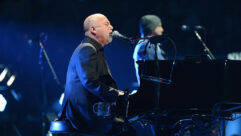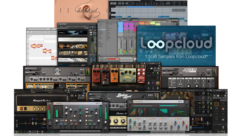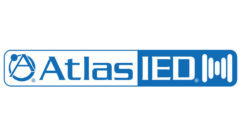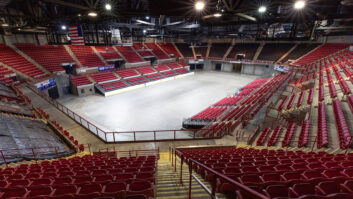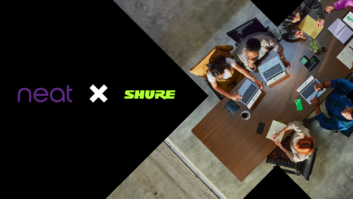
A Quick Worship Audio Set Up and Break Down, Part 2
Oct 16, 2013 2:59 PM,
With Bennett Liles

Listen to the Podcasts
When the huge Bible study group Breakaway Ministries holds an event they use Reed Arena or the Texas A&M football stadium, Kyle Field. With a full band, the group calls in Puresound from Houston to set up a JBL VerTec sound system in only an hour. Wes Mathew from Puresound is here with the story on how they do it, coming right up on the SVC Podcast.
SVC: Wes, thanks for being back for part two on the SVC Podcast, from Puresound in Houston. You’ve got a task of setting up sound for a live band and a system to cover several thousand participants of Breakaway Ministries sometimes in Reed Arena, a basketball venue, and other times in the Kyle Field football stadium. You’ve got to have the whole thing set up in an hour. When it’s over, you and your crew have another hour to get it all out of there. You’re using the JBL VerTec line arrays. Now are there any special modifications that you’ve done to the gear to speed things up on getting it in and out of these places?
Wes Mathew: Not really any modifications. With these open fields and open arenas, we definitely have a problem with the low end, and so we experiment with the subs quite frequently. Sometimes we try to couple them all in the center and just have a huge, massive sub and sometimes I try to experiment where I do a left-right configuration with the sub, and that is sort of working out right now. We definitely need a lot more sub for this kind of big, open space because all the subs are omni-directional. You know, I lose a lot of it going to nowhere, you know, behind the band and everything. We’ve tried several experiments with trying to make a cardioid pattern of the subs using delay and some modifications on the BSS. Right now we’re still in the experimental stage on the subs, but yes, as far as that is concerned on modification, I think subs would be the definite change up every week. [Timestamp: 2:11]
What are the sound sources you’re dealing with? You mentioned a full band and then you have individual speeches or inspirational messages?
That’s correct, yeah. The band is definitely a full band. We have drums, bass, electric, acoustic, keys, vocals, loops, and so that’s an intense band. We do definitely have hired professional bands all the time—great-sounding people—and then definitely a speaker that gives the message for the night. And we do rolling videos and sometimes they bring in panels for live interviews and everything. We use DPA face mics. We have Shure wireless units that we use, the URs, which are definitely the best for our occasion. And then our antennas are RF Venue antennas. We definitely use this paddle with a combination of a whip paddle, it’s a new invention by RF Venue, maybe you know, for a few years now that we used. [Timestamp: 3:07]
And you’re just running 50Ω coax back to the receivers in a rack somewhere.
Yes. We have a monitor person right next to the stage and so we try to keep most of the wireless there at all times, and so they’re close. We’re probably, you know, 20ft.-30ft. away from all the microphones. And so that’s not far at all, but I always love full RF just to make sure I’m 100 percent bulletproof on any dropouts or RF interruption. [Timestamp: 3:30]
And in part one we were talking about this, but you’re using the JBL VerTec line arrays.
Yes, we have the JBL line arrays and he sets up right behind it, but there are no issues for that. But the line arrays have been the greatest increase in quality for us with clarity, intelligibility of the vocals, the fullness of the band, and just the way we can set it up. We can set it up as individual units versus groups of the stacks, and we can fly it. And so occasionally, when we have more people on the ground, we’ll rent an array truss tower. You know, we can fly the speakers and just the versatility, I think, has been the best thing; and the ease of it, the use, the putting it together. The fact that we can train volunteers is amazing, and I think all non-profits mostly are run by volunteers, and to have that ease of use and, you know, not have a higher learning curve on it, I think, is amazing. [Timestamp: 4:27]
A Quick Worship Audio Set Up and Break Down, Part 2
Oct 16, 2013 2:59 PM,
With Bennett Liles
What specific array unit were you using for this? The VerTec VT4888’s and what, the 4887’s?
Yeah, 88’s and 87’s are our mains, 81’s are our subs. We also have another set of JBL dual subs that we use as well. [Timestamp: 4:42]
What kind of a crew have you got for this? How many people have you got to get this big mad dash, one-hour setup done?
We have two full-time guys and 13 volunteers that help us put this together. And we actually run a summer training and also a January training before school starts. The Bible study is during the school year, and so we get those breaks to reteach new volunteers because every four years they do graduate and leave us, and so we do have to retrain teams and team leaders and they do an excellent job. And these students are excellent at what they do and we train. We do a practice run through and sometimes we get to practice at Reed Arena, sometimes we don’t, but we’ll set the full line array up. We’ll go through the mistakes, we’ll go through the angles, and we’ll teach them pretty much everything even though some of them don’t care about audio and video, but just the fact that they’re volunteering and want to help out this ministry, they’re in it and they’re in it 100 percent. It’s been amazing. [Timestamp: 5:40]
What do you consider to be the most important thing on this? I know you have to train people to handle the quick setup and strike. Is it how they handle the gear? Do you specialize people on the various jobs and parts of the system?
Yes. And so what we’ll do is we’ll break the teams up. We have about five teams. I have a front-of-house team, which manages setting up my console. We have a mass connect snake that makes it easy, so all they’ve got to do is pop it and lock. So it’s not like they have to go through each channel one-to-one, “Oh, here are the outputs.” And so the mass connect helps out. The front-of-house guys are also setting up my recording with Pro Tools, which we use the SE48 venue at front-of-house, and so it’s just a FireWire right into a laptop, which records. And then my second team is my monitor team. That team puts another console up, which we have the Soundcraft SI Expression 3 we’re currently using, and we have a split snake and that just pops right in. And they set up the wireless mics and also we use wireless in-ears for the band, and so they’re setting up the in-ears. My third team is my speaker team. The speaker team, we teach them how to put the line array together. There’s definitely a lot of safety issues with that, make sure they’re using their legs and not lifting with their back, not pinching their fingers—we make them wear gloves—and just making sure that all the pins are locked in because we don’t want the line array to fall over or anything or have any kind of hazardous issue. By the time they’re putting it up, one of the full-time guys does a safety check and we check all the pins to make sure they’re all secure. We make sure the line array and we make sure that all the staging and everything is OSHA certified. We make sure it’s seven times its rating or more. And then I have another team who does the stage. They will mic the band up; they’ll mic all the drums up. They will run all the drive lines. They will make sure and line check all my lines to front of house and monitors, making sure we’ve got tone in every channel. That kick drum is going to front of house, the kick drum is going to the monitor, and then snare and so on. And then my last team is the band team and as soon as the band rolls in they set up the drums, they set up the keyboards, they get everything in place along with the musicians and we push that because we do have a time limit and I have to fly through sound check quickly. And the fact that we have digital consoles helps greatly because most of the time we use a band that we have used before and I can recall the settings and we’re about 90 percent there. There are a few minor tweaks that we have to do. We’re not gonna get the line array in the exact same spot. We try to with a laser measurer and everything, but you know, there’s some instances where the seats are a little different or something happens. [Timestamp: 8:22]
This stuff is subjected to some rough going. What parts of the sound gear tend to get the worst of it with being busted and knocked off and torn loose or damaged?
Yeah, definitely as far as damage, it’s been a few years since we came into the picture and the most things we’ve seen are definitely cables. It’s not just because they’re cheap cables, it’s just because we’re moving in and out quickly and every week, so this is constantly getting packed, repacked, shuffled in a trailer and back out, so just like Speakon connectors would get crushed or pulled out, XLR cables—we’ve probably had a few that got cut and rolled over probably. One other main thing is sometimes the speakers get jarred, you know, going up and down ramps, down a trailer and sometimes they get jarred a little bit. And occasionally we have one or two amps that kind of got, I guess, damaged on the way. The great thing is JBL service is incredible that they next-day one immediately and so that’s fixed immediately. [Timestamp: 9:22]
Well, good support makes all the difference even if the gear itself is pretty good stuff. So what’s coming up for Puresound now? Do you have any interesting projects coming along?
Yeah, definitely. We are finishing up a few installations here in the Houston area. We have installed some digital consoles at some local churches, and also this fall Breakaway is doing a field setup actually on Simpson Field and this is going to be the first time for that. And so we are expecting at least 15,000-plus people to attend. The challenge with this is with the arena and the football field, the line array works great on the ground and we can shoot it up from the ground and just do kind of, like I say, like a backwards curve. On this field setup, we’ll have to fly most of the gear and so we’re actually going to get an 18-wheeler and basically it pops up and unfolds into a stage with a roof on it. And so we’ll fly at least 32 line arrays with 88’s and we’ll also get the array truss towers and we’ll be flying probably 16 more arrays on the side fills and we’ll also have a back delay for that system. But that’s definitely a new project and that is really big that we are planning now as we speak. [Timestamp: 10:38]
Well, that’s going to be something when it all comes together. I don’t know how you’re doing all that you’ve got going on now. Wes Mathew from Puresound in Houston. Thanks for joining us and giving us the details on rapid setups with the JBL VerTec line arrays in Reed Arena and Kyle Field at Texas A&M. Enjoyed it.
It’s been a pleasure.


